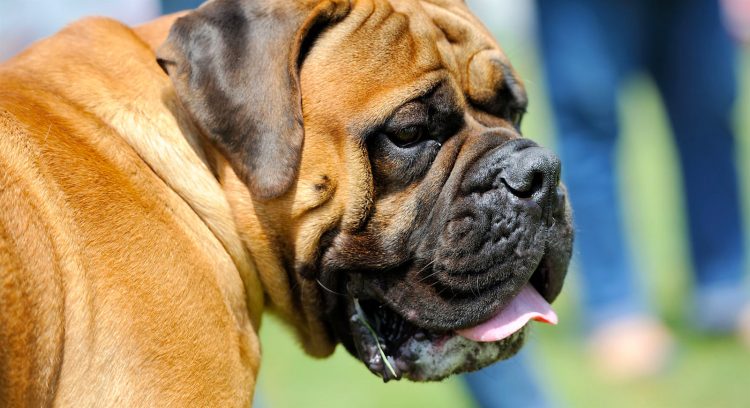

Working

120–230 lbs.

27–30 in.

6–10 years
Key Characteristics of Mastiff Breeds
This shorthaired gentle giant is a large, powerful dog and is high on our list of biggest dog breeds.
- Head: Mastiff breeds have large, square heads.
- Eyes: Brown or hazel eyes are common in mastiff breeds, surrounded by a dark mask.
- Ears: Mastiff breeds have small, V-shaped, dark-colored ears.
- Tail: The tail of mastiff breeds tapers down to the end and is set high.
- Coat: The coat of mastiff breeds can be short or medium in length, with colors including fawn, apricot, and brindle. Some white may also be seen, usually on the chest.
Origins of Mastiff Breeds
Mastiff breeds are ancient dogs with origins dating to 3000 B.C. in the form of drawings in Egypt.
- Historical Presence: Mastiff breeds were present when Caesar invaded Britain in 55 B.C. The dogs were so impressive to Caesar that he brought some of them back to Rome. There, mastiff breeds were used in gladiator and lion fights as well as bull baiting.
- British Use: British people kept mastiff breeds for protection from wolves and other predators around their homes.
- American Kennel Club Recognition: Mastiff breeds eventually appeared in the United States and were recognized by the American Kennel Club in 1885.
Today, mastiff breeds are companion pets and guard dogs who may participate in obedience, therapy, carting, tracking, conformation, search and rescue, and weight pulling.

How Friendly Are Mastiff Breeds?
Mastiff breeds are gentle and intelligent. They are eager to please and form strong bonds with their family members.
- Guarding Instinct: Mastiff breeds have a natural guarding instinct, meaning they will not attack but will do whatever is necessary to defend.
- Training: Mastiff breeds can be sometimes stubborn. Consistent training commands from puppy years to adulthood are crucial. If you allow something when your Mastiff is a puppy, their great memory will tell them they can always do it—even when your Mastiff reaches almost 200 pounds! Set clear ground rules and stick to them.
- Aggression: A Mastiff may appear aggressive when protecting the home or family members but shouldn’t be aggressive in nature. Thorough socialization is recommended, and intact males may fight for dominance.
- Family-Oriented: Mastiff breeds need to be close to family and should not be an outdoor-only dog. Isolation or long periods of separation can cause anxiety or destructive behaviors.
- House-Training: Mastiff breeds are easy to house-train and do not bark much unless they have a reason. They are also known to snore because of their long, soft palate, but this will vary with each individual dog.
Is a Mastiff Breed the Right Dog for You?
Exercise Needs of Mastiff Breeds
MEDIUM: Mastiffs require daily walks. Exercise for puppies should be limited up to 2 years old because of their bone growth. After that, feel free to implement an exercise routine, but start slowly and build up to longer walks or playtime.
- Daily Walks: Mastiffs require daily walks. Exercise for puppies should be limited up to 2 years old because of their bone growth. After that, feel free to implement an exercise routine, but start slowly and build up to longer walks or playtime.
- Outdoor Exercise: Your Mastiff should be exercised on a leash or in an enclosed area when outdoors. Mastiff breeds are relatively inactive indoors and can do well in apartments if their exercise needs are met outside.
- Yard Benefits: Your Mastiff would probably appreciate a yard, especially because of their instinctual love of digging.
Grooming Needs of Mastiff Breeds
MEDIUM: Brush the coat every day. A Mastiff will shed an average amount, and this can increase to heavier shedding twice a year.
- Daily Brushing: Brush the coat every day. A Mastiff will shed an average amount, and this can increase to heavier shedding twice a year.
- Drooling: Drooling is common, so keep some towels handy for when the need arises. Bathe the dog as needed.
- Teeth, Ears, and Nails: Keep the teeth cleaned—here’s why—and the same goes for your Mastiff’s ears and nails.
Health Problems in Mastiff Breeds
HIGH: There are several health concerns to be aware of for this breed:
- Cancer, more commonly osteosarcoma
- Cystinuria (stones in the kidneys or urinary tract)
- Hip dysplasia
- Elbow dysplasia
- Seizures
- Progressive retinal atrophy
- Cruciate ligament problems
- Dog bloat
- Ectropion
- Cardiomyopathy
This adorable dog shows off the stubborn side of Mastiffs:
Where to Adopt Mastiff Breeds
Start with our search page to find a big, beautiful Mastiff near you. If you contact breeders, make sure they don’t run a puppy mill (read about the red flags here). Ask for health clearances on the dog or the parents.
Frequently Asked Questions (FAQ)
How many mastiff breeds are there?
There are over 200 Mastiff breeds recognized worldwide.
What are the different mastiff breeds?
The different Mastiff breeds include the English Mastiff, Bullmastiff, Tibetan Mastiff, Neapolitan Mastiff, French Mastiff, Spanish Mastiff, Japanese Mastiff, South African Mastiff, American Mastiff, and Brazilian Mastiff.
What enviable feature does the american mastiff have that other mastiff breeds do not?
The American Mastiff has the enviable feature of producing less drool compared to other Mastiff breeds.
Additional Resources
- American Kennel Club’s Mastiff Page
- Mastiff Club of America
- The Old English Mastiff Club (United Kingdom)
- Canadian Mastiff Club



